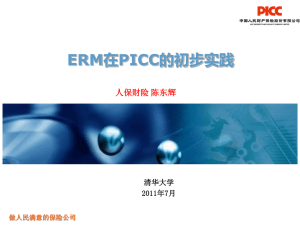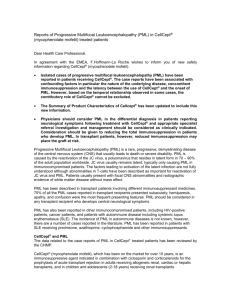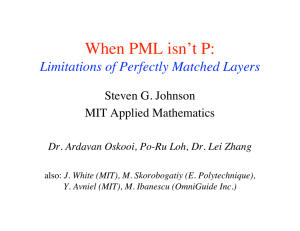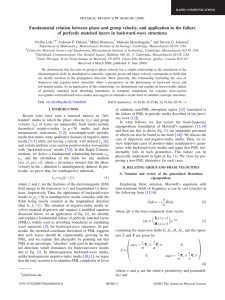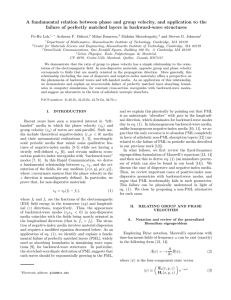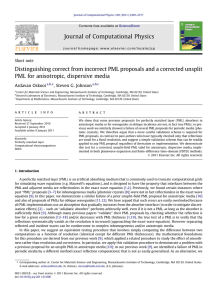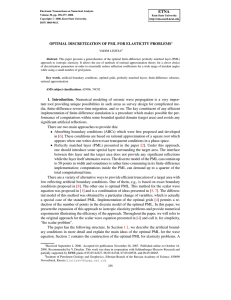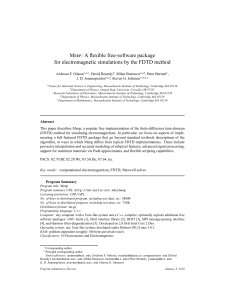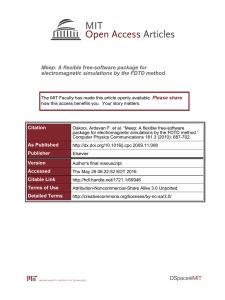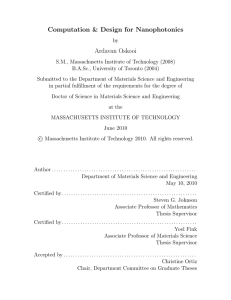Notes on the UPML implementation in Meep 1 Overview Steven G. Johnson
advertisement
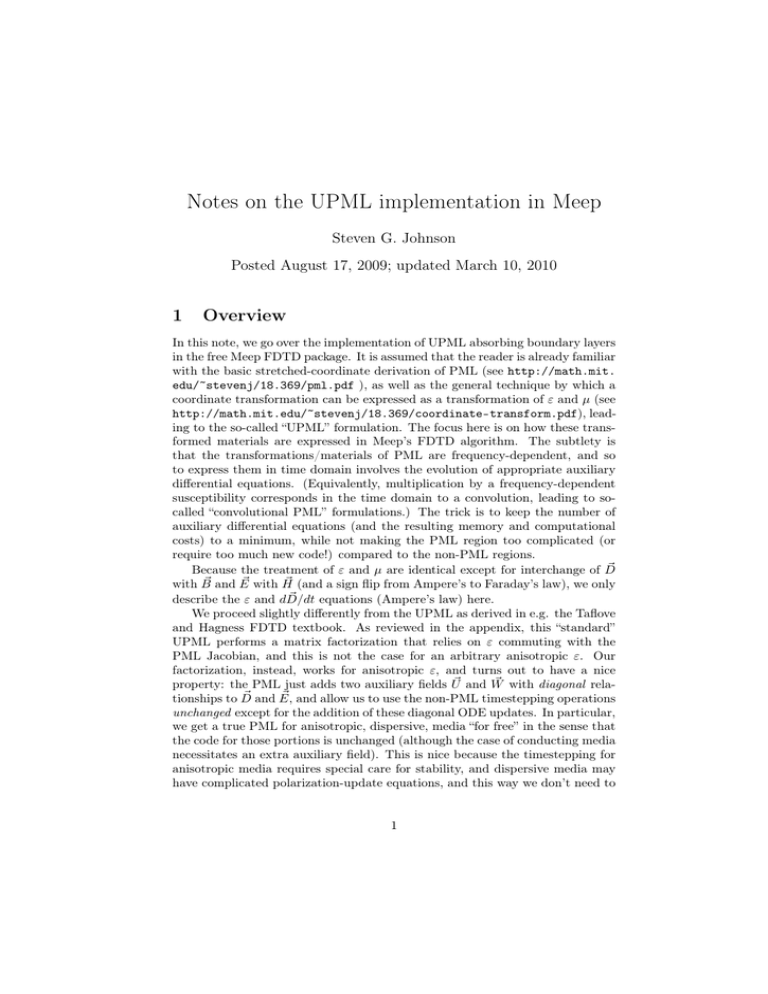
Notes on the UPML implementation in Meep Steven G. Johnson Posted August 17, 2009; updated March 10, 2010 1 Overview In this note, we go over the implementation of UPML absorbing boundary layers in the free Meep FDTD package. It is assumed that the reader is already familiar with the basic stretched-coordinate derivation of PML (see http://math.mit. edu/~stevenj/18.369/pml.pdf ), as well as the general technique by which a coordinate transformation can be expressed as a transformation of ε and µ (see http://math.mit.edu/~stevenj/18.369/coordinate-transform.pdf), leading to the so-called “UPML” formulation. The focus here is on how these transformed materials are expressed in Meep’s FDTD algorithm. The subtlety is that the transformations/materials of PML are frequency-dependent, and so to express them in time domain involves the evolution of appropriate auxiliary differential equations. (Equivalently, multiplication by a frequency-dependent susceptibility corresponds in the time domain to a convolution, leading to socalled “convolutional PML” formulations.) The trick is to keep the number of auxiliary differential equations (and the resulting memory and computational costs) to a minimum, while not making the PML region too complicated (or require too much new code!) compared to the non-PML regions. ~ Because the treatment of ε and µ are identical except for interchange of D ~ ~ ~ with B and E with H (and a sign flip from Ampere’s to Faraday’s law), we only ~ describe the ε and dD/dt equations (Ampere’s law) here. We proceed slightly differently from the UPML as derived in e.g. the Taflove and Hagness FDTD textbook. As reviewed in the appendix, this “standard” UPML performs a matrix factorization that relies on ε commuting with the PML Jacobian, and this is not the case for an arbitrary anisotropic ε. Our factorization, instead, works for anisotropic ε, and turns out to have a nice ~ and W ~ with diagonal relaproperty: the PML just adds two auxiliary fields U ~ and E, ~ and allow us to use the non-PML timestepping operations tionships to D unchanged except for the addition of these diagonal ODE updates. In particular, we get a true PML for anisotropic, dispersive, media “for free” in the sense that the code for those portions is unchanged (although the case of conducting media necessitates an extra auxiliary field). This is nice because the timestepping for anisotropic media requires special care for stability, and dispersive media may have complicated polarization-update equations, and this way we don’t need to 1 modify any of that in the slightest for the PML. Our approach also makes a ~ update equation (from ∇ × H) ~ and terms that clean separation between the D ~ update equation (from the constitutive equations), and correspondaffect the E ingly in the Meep code these are handled separately in step_db and update_eh, respectively. 2 Non-PML materials in Meep In Meep, we support dispersive media ε(ω) of the form: iσD ε(ω) = 1 + [ε∞ + χE (ω)] , ω where σD is a conductivity (which may be anisotropic, but must be diagonal in Cartesian coordinates and hence commutes with J ), ε∞ is a non-dispersive part of the permittivity (which may be non-diagonal anisotropic) and χE (ω) is some additional dispersive part (possibly anisotropic) implemented by auxiliary ODEs ~ (currently, a sum of Lorentzians). This corresponds, in that solve P~ = χ(ω)E time-domain, to Ampere’s law of the form: ~ ~ ~ =∇×H ~ = ∂ D + σD D, K ∂t (1) ~ by K ~ for later convenience, and a constitutive equation denoting ∇ × H ~ = ε∞ E ~ + P~ , D ~ (We where P~ is time-evolved via a system of ODEs derived from P~ = χ(ω)E. ~ don’t include free currents J here, since they have no impact on the PML equations, and indeed one rarely puts free currents inside the PML anyway.) In FDTD, we discretize these in space and time. Let us denote the time ~ n denotes D(n∆t), ~ discretization by a superscript: D and similarly for P~ n and n ~ ~ n+0.5 and E . The magnetic fields are offset in time by half a time step, giving H n+0.5 n+1 ~ ~ ~ n and K . To time-step these fields in FDTD, we first compute D from D n+0.5 n+1 n+1 n+1 ~ ~ ~ ~ K by the curl equation, then compute E from D and P by the constitutive equation, and finally compute P~ n+2 . (Note that, with Lorentzian ~ n+1 . dispersion, we can compute P~ n+2 from P~ n+1 and P~ n given E Using the standard second-order center-difference approximations, the equa~ becomes: tion for D ~ n+1 − D ~n ~ n+1 + D ~n D ~ n+0.5 = D K + σD , ∆t 2 giving ~ n+1 = D σD ∆t 1+ 2 −1 σD ∆t 1− 2 2 n n+0.5 ~ ~ D +K . (2) The constitutive equation is simply: ~ n+1 − P~ n+1 . ~ n+1 = ε−1 D E ∞ (3) (This is nontrivial to implement correctly for anisotropic media [Werner and Cary, 2009], but the details need not concern us here.) 3 PML formulation in frequency domain PML is simplest to derive in frequency domain, where the fields all have timedependence e−iωt . An ordinary PML in Cartesian coordinates is derived by a complex coordinate stretching, where each coordinate is stretched by a factor sx,y,z = 1 + iσx,y,z , ω where ω is the frequency and σ is the PML “conductivity.” For example, to terminate the cell in the x direction, only σx is nonzero. These coordinate stretchings can be absorbed into Maxwell’s equations as a change in ε and µ. The original permittivity ε in the PML region is replaced by an effective tensor ε̃ given by J εJ T ε̃ = , det J −1 −1 where J = diag(s−1 x , sy , sz ) is the Jacobian matrix of the coordinate stretching. In frequency domain, replacint ε(ω) with ε̃, eq. (1) becomes: −1 −1 sx sx iσ ~ = ∇×H ~ = −iωsx sy sz 1 + D s−1 K [ε + χ (ω)] ∞ E y ω s−1 z (4) Although this is straightforward to implement in frequency domain, where one ε(ω) is as good as another, in the time domain a frequency-dependent term requires care. In time-domain, a frequency-dependent term can be thought of as a convolution with a filter (hence the viewpoint of a “convolutional PML” adopted by some authors), where in the language of signal-processing we wish to find a stable recursive filter to implement this convolution with as few taps as possible (to minimize the memory and computational burden). Equivalently, the frequency dependence may be implemented by auxiliary ordinary differential equations (discretized ODE = recursive filter). The most convenient ODEs to discretize are first-order ODEs. For example, a = sb = (1 + iσ/ω)b gives db −iωa = −iωb + σb, which corresponds to the first-order ODE da dt = dt + σb. So, before we proceed to time domain, we want to factorize eq. (16) into terms with only one factor of s (or σ/ω) each (or ratios of single s factors). In ~ and introduce new auxiliary doing so, we are free to change the definition of D 3 s−1 y s−1 z ~ E. fields as desired, since the fields in the PML region are not physical. A key trick is the factorization: −1 sx sy sz = . s−1 sz sx sx sy sz y s s s−1 x y z ~ U ~ , and W ~ , we can Using this factorization, and defining new auxiliary fields, C, factorize eq. (16) into the following equivalent form (giving the same relationship ~ and E): ~ between H ~ ~ =∇×H ~ = −iω 1 + iσD C K ω −1 sy ~ ~ = C U s−1 z −1 sx −1 sz ~ ~ = U s−1 D x s−1 y ~ = ε−1 ~ ~ W ∞ D−P ~ P~ = χE (ω)W sx ~ = ~ W sy E sz 4 (5) (6) (7) (8) (9) (10) PML formulation in time domain Given eqs. (5–10), a time-domain formulation is now easy because each equation only includes first-order factors in ω (corresponding to first-order time derivatives). Moreover, all of the nontrivial equations, namely (5), (8), and (9), are exactly the same as in the non-PML case, meaning that we can use exactly the ~ and W ~ instead of D ~ and E. ~ The other same code except passing new fields C equations are diagonal ODEs that are trivial to implement. It may seem wasteful to have three new auxiliary fields, but in many cases they can be omitted: except in corners of the computational cell, one has PML only in one direction that only one component of sx,y,z is 6= 1, and in these cases one need only store ~ and one component of W ~ (with the other components reone component of U ~ and E, ~ respectively); C ~ can be omitted in non-conducting materials placed by D (σD = 0). For completeness, we write out the equations here, in the order that they ~ update from eq. (5) is identical to the D ~ timestep would be evaluated. The C 4 from eq. (11) ~ n+1 = C 1+ σD ∆t 2 −1 1− σD ∆t 2 ~n + K ~ n+0.5 . C (11) ~ is updated from the corresponding component of C ~ Each component Uk of U by the ODE dUk /dt + σk+1 Uk = dCk /dt (where σk±1 is interpreted as a cyclic shift, e.g. σy+1 = σz , σz+1 = σx ), giving: Ukn+1 = 1+ σk+1 ∆t 2 −1 1− σk+1 ∆t 2 Ukn + Ckn − Ckn−1 . (12) ~ is then updated from the corresponding component of U ~ Each component of D by the ODE dDk /dt + σk−1 Dk = dUk /dt, giving: Dkn+1 −1 σk−1 ∆t σk−1 ∆t n−1 n n 1− Dk + Uk − Uk . = 1+ 2 2 ~ is then updated from D ~ − P~ exactly as in eq. (14): W n+1 n+1 ~ n+1 = ε−1 ~ ~ W D − P . ∞ (13) (14) ~ is updated from each component of W ~ by the ODE Then, each component of E dEk /dt = dWk /dt + σk Wk , giving: σk ∆t σk ∆t Wkn+1 − 1 − Wkn . (15) Ekn+1 = Ekn + 1 + 2 2 ~ , exactly as for the non-PML Finally, P~ n+2 is computed using P~ = χE (ω)W ~ ~ case (but with W replacing E). Note that, in order to avoid having to save the fields from the previous ~ U ~ , and D ~ updates [eqs. (11–13)] timestep in yet more auxiliary arrays, the C, ~ and E ~ updates [eqs. (14– have to be performed in a single loop body, while the W 15)] must be performed in another single loop body. [One cannot easily merge the two loops because the offdiagonal anisotropic terms in ε−1 ∞ combined with the staggered Yee grid mean that eq. (14) is effectively nonlocal in space, requiring ~ n+1 components at several spatial points to determine W ~ n+1 . Separating D the two loops has the additional advantage that it reduces the combinatorial explosion of the number of material cases that must be handled.] 5 Appendix: Textbook isotropic, nondispersive PML In this appendix, we review the standard “textbook” UPML for isotropic nondispersive media as found in, for example, Taflove and Hagness. It is important 5 to distinguish mere differences in notation (the derivation in T&H is far less compact than the one here) from substantive differences, and in particular the usual UPML corresponds to a different factorization of eq. (16) than ours. This textbook formulation only works for isotropic (or at least diagonal) ε, because it assumes that an arbitrary diagonal matrix commutes with ε. In particular, dropping the σD and χE terms (assuming nondispersive media), the textbook PML formulation corresponds to the following refactorization of eq. (16): ~ =∇×H ~ = −iω K sy sz sz sx ε∞ sx sy sx This then factorizes into two equations: ~ =∇×H ~ = −iω K sy sz ~ E. (16) sy ~ D, sz sx ~ = ε−1 E ∞ sx sz sy sx sz sy ~ D. The former discretizes similarly to eq. (2), with the PML σy,z,x taking the place of σD , and the latter turns into the ODE dEk /dt+σk−1 Ek = ε−1 ∞ [dDk /dt+σk Dk ] which is easily discretized. ~ and E. ~ If a conductivity σD (or similar) Only two fields need be stored: D ~ (or similar). It is included, however, one needs an additional auxiliary field C ~ ~ turns out that the case of a dispersive P = χE (ω)E can also be handled with no additional storage compared to the non-PML case, at least for a Lorentzian χE that requires both P~ n+1 and P~ n to be stored anyway. So, the main cost of the ~ and W ~ must be stored Meep formulation is that two additional auxiliary fields U in the PML; however, this is actually only a slight additional burden in storage ~ and W ~ actually must since for most PML regions only one component of U be stored (see above). The main problem with the textbook implementation is that it fails for anisotropic media (even if one naively plugs a tensor ε−1 ∞ ~ update, the reflection will not go to zero with increasing resolution). into the E This is especially important given the fact that, even for nominally isotropic media, accurate subpixel averaging requires the discretization to use effective anisotropic media at material boundaries. 6

